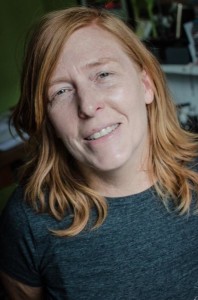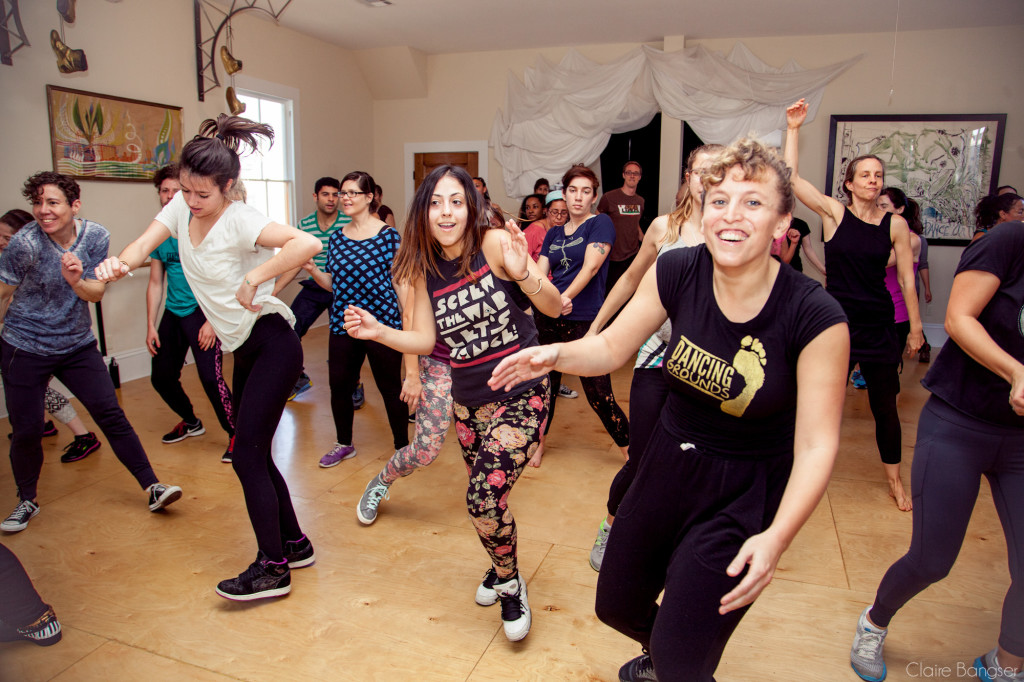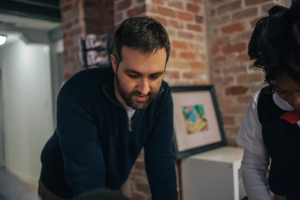
House in Upper Ninth Ward, New Orleans. Image: Infrogmation of New Orleans/Flickr
One Tuesday morning, Laura Stein woke up in Brooklyn and decided to move to New Orleans. “I basically just wanted a life change,” said Stein, 34. She had worked in nonprofit managements and public policy but dance is the love of her life. So she rented a narrow white house with orange shutters on Dauphine Street, three blocks from the Mississippi River in downtown New Orleans, and put an outline of a foot on the front door.
Inside, in the front room of a narrow shotgun house on St. Claude Avenue in the city’s upper 9th Ward, a working-class neighborhood known for its artistic character, Stein made a DIY dance studio, buying pieces of mirrors to hang on the walls. Her friend Jessi Donley dubbed the place Dancing Grounds and the two held dance classes that consistently attracted a few dozen people, then expanded programming until they had eight well-attended classes each week. When they held recitals in the house’s backyard, about 200 people usually showed up.
“I realized I’d tapped into a need,” said Stein, who studied dance at Wesleyan University and in New York, Los Angeles and London, and has a master’s degree in public administration. Her experience leading nonprofits like Dancewave, which brings dance into New York City public schools, informed her decision to establish Dancing Grounds as one. Its mission: make dance accessible to lower-income New Orleanians, and people with a wide variety of body types and imperfect dance techniques, through low-cost classes and a laid-back approach meant to encourage beginners who might be daunted by a traditional dance studio.
New Orleans has always been a magnet for young artists like Stein, looking for an urban muse and attracted to the city’s tropical climate and unique rich blend of Afro-Caribbean and Francophile cultures. For more than a century, once artists have made their way to New Orleans, they have found new spots for themselves here. As New Orleans jazz musicians say to a new musician jumping in with the band, these artists have been able to “get in where you fit in.”
But after Hurricane Katrina, it began to feel as though newcomers were trying to conquer, change and displace as they moved into this historically high-poverty city with lots of disposable cash, buying up historic homes and patronizing a rash of new high-priced, haute-cuisine restaurants. It only rubbed salt in the wounds when media accounts of the 10th anniversary of Katrina this summer portrayed these young entrepreneurs as the college-educated, moneyed saviors of New Orleans, a city that has long sagged educationally and economically.
Within this heightened climate, whether newcomers seem to be reviled or adored, there is a middle ground.
“I see people trying to change the New Orleans culture. But Laura didn’t come down here pretending to know. She came in respecting, accepting and embracing,” said Kristal Jones, 28, a New Orleans native and dance instructor. Dancing Grounds instructors also teach five hundred students during the school day at two nearby schools, Arise Academy and Akili Academy.
Stein and others have chosen to work alongside native New Orleanians to create a new arts-education node in the upper 9th Ward, thanks partly to Gary Lavigne, a philanthropic-minded landlord who created a few spaces for them alongside two newly renovated public school buildings on St. Claude Avenue. One of those spaces, across the street from Dancing Grounds, is the Press Street Community Arts Center, where a program called Big Class launched an after-school writing studio for neighborhood kids.
Several years ago, Big Class’ founder Doug Keller, then a schoolteacher, got into a good groove with his class of forty-three first graders and wrote a book called Big Class No. 1: Animals. An old friend of Keller’s designed the book; he and the classroom’s teaching artist recruited a network of adult artists to illustrate it; they self-published 250 copies financed by a Kickstarter campaign. Though the school had little luck with parental participation, Keller and his fellow teachers called every parent, asking them to come to the book’s debut and reading at a local library.
That night, the crowd totaled 150 people. “The students didn’t only bring their parents. They brought their entire families. It was a high point,” said Keller, who had moved to New Orleans several years before as a Teach For America member determined to make a different life for himself here than what he had experienced as a young writer working in the film industry, reading scripts for Ben Stiller’s production company in Los Angeles and contributing to The Onion in New York. “I wanted out of the New York/L.A. trap that a lot of creative people get into,” he said.
Soon, other teachers and community leaders encouraged Keller to turn Big Class from a module of classroom curriculum into a stand-alone citywide program. “People would tell me, ‘We need this,’” he said. Keller now operates the Big Class Open Studio in Press Street and works during the day within city schools to help students’ writing skills flourish through books they create.
Within the city’s post-Katrina newcomer backlash, perhaps no group has been viewed more suspiciously by longtime New Orleanians than Teach For America participants. Over the past few decades, the New Orleans-area program has grown by more than 500 percent: from 45 teachers in pre-Katrina days to more than 300 now. Today, 1 in 5 teachers in New Orleans are TFA members or alumni, according to TFA data. And for locals who saw the city’s seasoned, largely African American teaching force of 4,600 fired en masse after Katrina as part of the state’s school reform efforts in New Orleans, it seemed arrogant to assume that unseasoned, often white, TFA teachers could replace the wisdom and hard work of the city’s seasoned teaching force.
Keller is well aware of this dynamic and, in recent years, began participating with the local teachers union’s efforts to further inclusive education, through programs like the local chapter of SEED (Seeking Educational Equity and Diversity), a teacher-led teaching program that works to make schools “more inclusive and fair.” Like Stein, Keller hired lifelong New Orleanians for his staff and incorporated input from a diverse range of people who had worked on the ground in New Orleans into the group’s mission.
Across the city, charter schools have leaned on nonprofits like Dancing Grounds and Big Class to perform functions that were once provided by a central administrative office, according to the education-data analysts at the Cowen Institute in New Orleans, who found a “heavy reliance on nonprofits” in the city’s post-Katrina school system.
From an office within a renovated charter school a half-block from Big Class and Dancing Grounds, Justin Lamb, 30, does recruiting and admissions for Bard Early College, which allows high school students to finish their first year of college by studying with Bard for half-days during their junior and senior years.
Lamb, too, came to New Orleans as a young Teach For America volunteer, at a time when thousands of other college students were flocking here, to muck out and rebuild flooded houses, build playgrounds and plant trees. “I came here without knowing a whole lot about New Orleans,” said Lamb, though he inherited some instant roots from an older brother, Jared Lamb, a former TFA member who still works in the city’s schools.
At first, Lamb – like Keller – spent a good share of his time with fellow TFA teachers. He arrived during the peak of post-Katrina volunteerism. During spring breaks at that time, the city crawled with young people in work gloves and tool belts. In subsequent years, some of the volunteers have returned, creating another stream of newcomers.
Many locals judge newcomers by whether they have been able to join local groups without viewing themselves as saviors who need to take over or change the way things are done. Not long after his arrival, Lamb fell in with already-established groups like Slam New Orleans, a longtime team of spoken word performers that hosts monthly open mic nights around town and competes in national poetry slam events.
It was from fellow Slam performers that Lamb began to think critically about the program that had brought him to the city. “I learned that everyone wasn’t ‘yay rah rah’ about the work I was doing as a member of TFA,” he said, noting that the chief criticism he heard was about the “temporary nature of TFA,” which only requires a two-year teaching commitment from its members, creating a constant flow of teachers in and out of participating schools.
In this small town, where artists generally know each other, Stein and Keller have both become fans of Lamb’s slam performances. In general, audiences go wild for him, which is why he’s represented Slam New Orleans for four years at regional and national competitions and was part of the five-member team from New Orleans that won the National Poetry Slam in 2013.
One of Lamb’s recent slam pieces, “Tips for Climbing Barbed Wire,” is written from the perspective of a teacher.
“Like so many boys his age, Daniel loves sports, hates walking in silent lines, thinks school lunch tastes like prison food. He would know. First day of school, he arrived with a jumble of silly bands circling his wrist and a government-monitored bracelet at his ankle. On the second day, he tells me to go f*** myself for telling him to go to speech class; he apologizes on the third. The principal calls this progress. Daniel is fourteen going on twenty-five, reads like he’s six. He says he’d like to rejoin his class someday, as long as they don’t tell him nothin’. Problem is, someone is always telling Daniel somethin’.”
As Lamb continues with his narrative to a rapt audience, he is decisive, even in-your-face. Off-stage, he is almost shy. When asked what his personal New Orleans looks like, he demurred in a quiet, diplomatic way that also seemed apt within the city’s charged post-Katrina atmosphere. “I would be hesitant to say that I have a New Orleans,” Lamb said. “I feel really honored to be part of the city.”
•
 Katy Reckdahl is a New Orleans-based news reporter who is a frequent contributor to the New Orleans Advocate and the Hechinger Report and has written for The Times-Picayune, The New York Times, The Daily Beast, The Weather Channel, The Nation, Next City, and the Christian Science Monitor.
Katy Reckdahl is a New Orleans-based news reporter who is a frequent contributor to the New Orleans Advocate and the Hechinger Report and has written for The Times-Picayune, The New York Times, The Daily Beast, The Weather Channel, The Nation, Next City, and the Christian Science Monitor.


